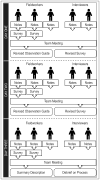Rapid assessment of clinical information systems in the healthcare setting: an efficient method for time-pressed evaluation
- PMID: 21170469
- PMCID: PMC3746487
- DOI: 10.3414/ME10-01-0042
Rapid assessment of clinical information systems in the healthcare setting: an efficient method for time-pressed evaluation
Abstract
Objective: Recent legislation in the United States provides strong incentives for implementation of electronic health records (EHRs). The ensuing transformation in U.S. health care will increase demand for new methods to evaluate clinical informatics interventions. Timeline constraints and a rapidly changing environment will make traditional evaluation techniques burdensome. This paper describes an anthropological approach that provides a fast and flexible way to evaluate clinical information systems.
Methods: Adapting mixed-method evaluation approaches from anthropology, we describe a rapid assessment process (RAP) for assessing clinical informatics interventions in health care that we developed and used during seven site visits to diverse community hospitals and primary care settings in the U.S.
Setting: Our multidisciplinary team used RAP to evaluate factors that either encouraged people to use clinical decision support (CDS) systems or interfered with use of these systems in settings ranging from large urban hospitals to single-practitioner, private family practices in small towns.
Results: Critical elements of the method include: 1) developing a fieldwork guide; 2) carefully selecting observation sites and participants; 3) thoroughly preparing for site visits; 4) partnering with local collaborators; 5) collecting robust data by using multiple researchers and methods; and 6) analyzing and reporting data in a structured manner helpful to the organizations being evaluated.
Conclusions: RAP, iteratively developed over the course of visits to seven clinical sites across the U.S., has succeeded in allowing a multidisciplinary team of informatics researchers to plan, gather and analyze data, and report results in a maximally efficient manner.
Similar articles
-
The future of Cochrane Neonatal.Early Hum Dev. 2020 Nov;150:105191. doi: 10.1016/j.earlhumdev.2020.105191. Epub 2020 Sep 12. Early Hum Dev. 2020. PMID: 33036834
-
Adapting rapid assessment procedures for implementation research using a team-based approach to analysis: a case example of patient quality and safety interventions in the ICU.Implement Sci. 2020 Feb 22;15(1):12. doi: 10.1186/s13012-020-0972-5. Implement Sci. 2020. PMID: 32087724 Free PMC article.
-
Clinical decision support in small community practice settings: a case study.J Am Med Inform Assoc. 2011 Nov-Dec;18(6):879-82. doi: 10.1136/amiajnl-2010-000013. Epub 2011 Apr 19. J Am Med Inform Assoc. 2011. PMID: 21504995 Free PMC article.
-
Expert clinical rules automate steps in delivering evidence-based care in the electronic health record.Comput Inform Nurs. 2006 Jul-Aug;24(4):196-205; quiz 206-7. doi: 10.1097/00024665-200607000-00005. Comput Inform Nurs. 2006. PMID: 16849914 Review.
-
Costs and benefits of health information technology.Evid Rep Technol Assess (Full Rep). 2006 Apr;(132):1-71. doi: 10.23970/ahrqepcerta132. Evid Rep Technol Assess (Full Rep). 2006. PMID: 17627328 Free PMC article. Review.
Cited by
-
Assessing Vietnamese American patient perspectives on population genetic testing in primary care: A community-engaged approach.HGG Adv. 2022 Aug 6;3(4):100134. doi: 10.1016/j.xhgg.2022.100134. eCollection 2022 Oct 13. HGG Adv. 2022. PMID: 36039118 Free PMC article.
-
Responding to a surge in overdose deaths: perspectives from US syringe services programs.Harm Reduct J. 2022 Jul 19;19(1):79. doi: 10.1186/s12954-022-00664-y. Harm Reduct J. 2022. PMID: 35854351 Free PMC article.
-
Interdisciplinary team-based care for patients with chronic pain on long-term opioid treatment in primary care (PPACT) - Protocol for a pragmatic cluster randomized trial.Contemp Clin Trials. 2018 Apr;67:91-99. doi: 10.1016/j.cct.2018.02.015. Epub 2018 Mar 6. Contemp Clin Trials. 2018. PMID: 29522897 Free PMC article.
-
LGBTQ bullying: a qualitative investigation of student and school health professional perspectives.J LGBT Youth. 2020;17(3):280-297. doi: 10.1080/19361653.2019.1653808. Epub 2019 Aug 20. J LGBT Youth. 2020. PMID: 33224407 Free PMC article.
-
Development and application of a qualitative rapid analysis framework in a hybrid trial within primary care.BMJ Open. 2024 Jul 24;14(7):e076792. doi: 10.1136/bmjopen-2023-076792. BMJ Open. 2024. PMID: 39053958 Free PMC article. Clinical Trial.
References
-
- Blumenthal D. Stimulating the adoption of health information technology. N Engl J Med. 2009 Apr 9;360(15):1477–9. - PubMed
-
- Kaplan B, Shaw NT. Future directions in evaluation research: people, organizational, and social issues. Methods Inf Med. 2004;43(3):215–31. - PubMed
-
- Hunt DL, Haynes RB, Hanna SE, Smith K. Effects of computer-based clinical decision support systems on physician performance and patient outcomes: a systematic review. JAMA. 1998 Oct 21;280(15):1339–46. - PubMed


